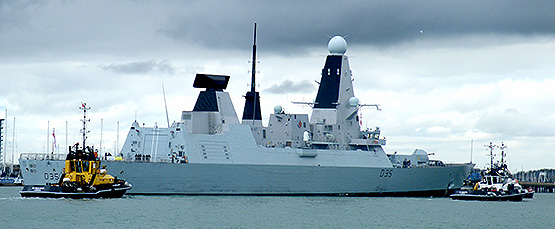#DaringDestroyer – One of the most modern high-tech UK naval destroyer's, the Type 45 HMS Dauntless (D33) is to make a first visit to Dublin Port this weekend, writes Jehan Ashmore.
Afloat understands this will be the first ever visit of a Type 45 destroyer to the Republic and follows last year’s visit of a sister HMS Duncan which made an inaugural visit to Belfast, her adopted city.
The 152m long ‘Daring’ class destroyer displacing 8,000 tonnes has a striking stealth superstructure to reduce radar signature detection likewise of a the smaller Dutch class frigate which paid a recent visit.
HMS Dauntless has an impressive array of weapons, and is notable as the first Daring class destroyer to fire the new Sea Viper missile, despite been the second in the series to be commissioned in 2010.
The Sea-Viper Missiles are the principal anti-air missile system which provides all-round defence – not just for the destroyer but for an entire naval task group. The system is to be used against all aerial threats some 70 miles away. In addition the missiles race towards its target at speeds in excess of Mach Four (over 3,000mph) using a series of tiny jets to manoeuvre, carrying out sharp turns at G forces no human could endure.
Another weapons system is the Phalanx, one of the most deadly last lines of defence for the Royal Navy. Phalanx is capable of engaging targets around one mile away, it is a radar-controlled Gatling gun which fires 20mm shells, spewing out 3,000 rounds a minute.
Mounted on the forecastle is a MK8 Gun which is featured on all Royal Navy destroyers and frigates.
She is also equipped with a Sampson radar, which is a sophisticated multi-function radar, an essential part of the air defence system for the Type 45.
Destroyers such as HMS Dauntless which has a crew of 180 can also take 60 troops and together they play an integral part in forming the backbone of the Royal Navy, committed around the world 365 days a year hunting pirates, drug runners or submarines, defending the Fleet from air attack.
In May, HMS Dauntless returned to her homeport, Portsmouth following a deployment to the Gulf in the Middle East where she spent the bulk of her time supporting US carrier operations in the on-going struggle against the fundamentalists of Isis.
In her breaks between providing air defence for US Navy flat-tops, HMS Dauntless visited Kuwait, Dubai plus Abu Dhabi and Bahrain, hub of RN operations in the Middle East.
During the four month deployment, HMS Dauntless sailed more than 47,000 miles, providing crucial support to Charles De Gaulle’s strike operations against ISIL – and before her USS Carl Vinson.
The aircraft carrier conducted maritime security patrols, reassuring the merchant traffic that the world depends on global trade.
The destroyers also participate in providing humanitarian aid after natural disasters. In such conditions the role of the stern flight deck is aided by a Chinook helicopter.






























































